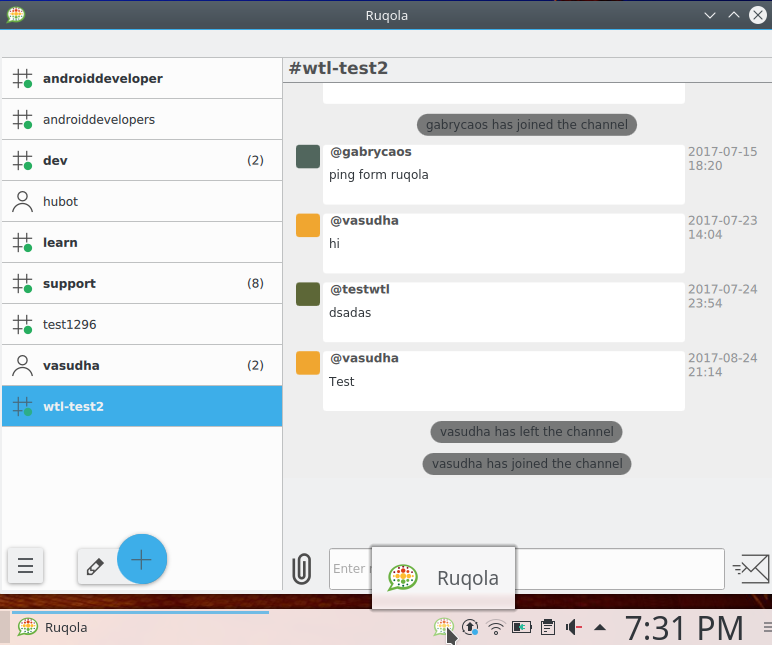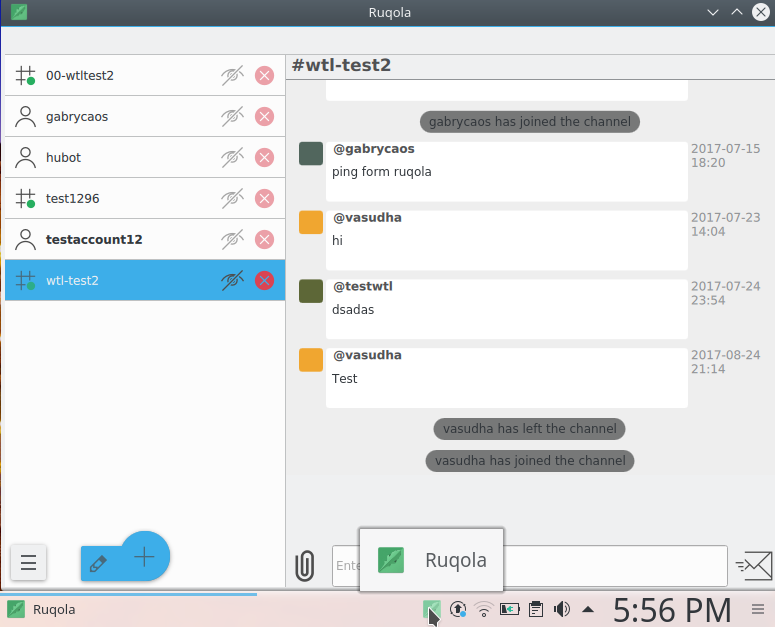GSoC/2017/StatusReports/Vasudha: Difference between revisions
No edit summary |
No edit summary |
||
| Line 29: | Line 29: | ||
== Screenshots == | == Screenshots == | ||
'''Login Page''' | |||
# '''Login Page''' | |||
Ruqola provides user login using username and password combination. It uses an authentication token which is saved locally in order to automatically authenticate the user the next time he tries to use the client. | |||
Ruqola will also support federated login (using OAuth2) as soon as Rocket.Chat provides an API for it ([https://github.com/RocketChat/Rocket.Chat/issues/7413/ Issue#7413]) | |||
[[File:login.png]] | [[File:login.png]] | ||
'''Support for | |||
# '''Support for rooms, direct chat, unread messages, system tray and a kirigami-UI''' | |||
There are a lot of things to notice in this screenshot. Let's get them one by one. | |||
* '''Rooms''': A room can be a channel or a group. Usually there are 'public channels' and 'private groups'. Features for rooms include- | |||
** Leaving a room | |||
** Hiding a room | |||
* '''Direct chat''': This enables one-to-one direct chat between two users. | |||
* '''Support for unread messages''': Room containing unread messages is highlighted in bold and also displays the number of unread messages for that room. | |||
* '''System tray''': (For desktop) Enables a systray used to minimize or maximize the application, and to display notifications. On closing the application from the "cross" at top right corner does not close the application, but minimizes it to the systray. It contains a menu having an option to Quit, by which the application is actually closed. | |||
* '''Kirigami UI''': Ruqola uses Kirigami for its user interface. (A big hug to the kirigami guys :D ) | |||
[[File:unread-messages-group-chat.png]] | [[File:unread-messages-group-chat.png]] | ||
'''Support for Leaving a channel''' | # '''Support for Leaving a channel''' | ||
[[File:leaving-room.png]] | [[File:leaving-room.png]] | ||
'''Global drawer having options for changing preferences, logging out, and quitting the application.''' | # '''Global drawer having options for changing preferences, logging out, and quitting the application.''' | ||
[[File:global-drawer.png]] | |||
== Contact Info == | == Contact Info == | ||
Revision as of 11:03, 27 August 2017
Title: Ruqola
Ruqola is a Qt interface to Rocket Chat, with a library implementing DDP semantics, and a Kirigami UI for both desktop and mobile. The application is a QML/C++/Qt app, thus providing multi-platform portability. There is currently no native Rocket.Chat client; Ruqola is the first generic cross-platform chat application based on Rocket.Chat.
It offers features such as login and logout, sending and receiving messages, notifications, group chats (channels/rooms), direct chats, leaving rooms, hiding rooms, unread messages, systray for desktop, and a kirigami-based UI.
Work Report
Repositories
Installation
Commits and Issues
Future Work
Blog Posts
Screenshots
- Login Page
Ruqola provides user login using username and password combination. It uses an authentication token which is saved locally in order to automatically authenticate the user the next time he tries to use the client. Ruqola will also support federated login (using OAuth2) as soon as Rocket.Chat provides an API for it (Issue#7413)
- Support for rooms, direct chat, unread messages, system tray and a kirigami-UI
There are a lot of things to notice in this screenshot. Let's get them one by one.
- Rooms: A room can be a channel or a group. Usually there are 'public channels' and 'private groups'. Features for rooms include-
- Leaving a room
- Hiding a room
- Direct chat: This enables one-to-one direct chat between two users.
- Support for unread messages: Room containing unread messages is highlighted in bold and also displays the number of unread messages for that room.
- System tray: (For desktop) Enables a systray used to minimize or maximize the application, and to display notifications. On closing the application from the "cross" at top right corner does not close the application, but minimizes it to the systray. It contains a menu having an option to Quit, by which the application is actually closed.
- Kirigami UI: Ruqola uses Kirigami for its user interface. (A big hug to the kirigami guys :D )
- Support for Leaving a channel
- Global drawer having options for changing preferences, logging out, and quitting the application.
Contact Info
Telegram Nick : vasudha_mathur
E-mail : [email protected]




